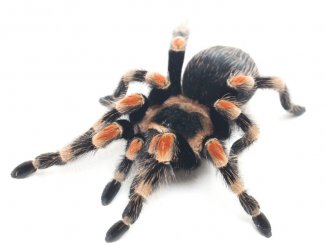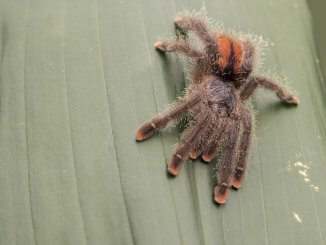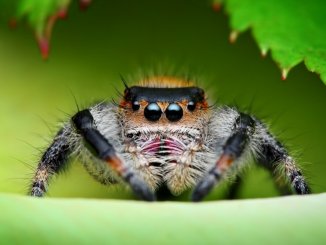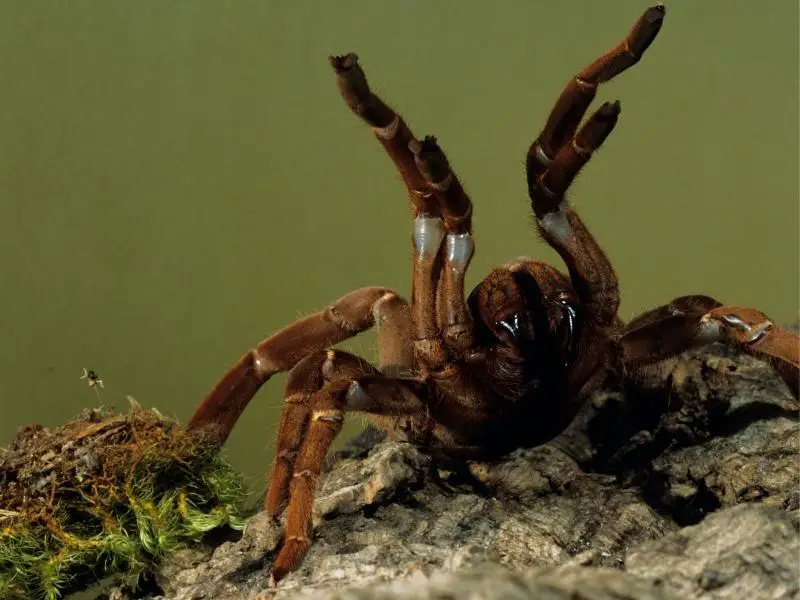
The king baboon is a large, copper-hued tarantula native to east Africa. King baboon tarantulas are known for their bold personalities, velvety hair, and unique, captivating behaviors. The spider is a burrowing species.
The king baboon tarantula isn’t suitable for beginner hobbyists because of its aggression and extremely painful bite.
King Baboon Tarantula Overview
| Common name | King baboon tarantula, king baboon spider |
| Scientific name | Pelinobius muticus |
| Natural habitat | East Africa, Kenya, Tanzania |
| Adult size | Up to 8 inches long |
| Average lifespan | Females up to 25 years, males up to 15 years |
| Diet | Carnivore |
| Housing | 15-gallon terrarium or larger, 68–78°F, 70%–80% humidity |
| Experience | Advanced |
Origin
King baboon tarantulas are native to east Africa, where they inhabit grasslands, shrublands, and acacia forests in Kenya and Tanzania. These spiders are terrestrial (ground-dwelling) and thrive in warm, humid environments with pliable substrate.
Despite its aggressive behavior, the king baboon spider is popular in the pet trade because of its unique copper color and impressive size. The tarantula isn’t considered endangered by the IUCN.
The king baboon tarantula was originally classified under the scientific name Citharischius Crawshayi. The spider is the only known species in the genus Pelinobius.
The king baboon spider’s venom is potent and produces a sharp, burning localized pain in humans. According to recent studies, the spider’s venom can potentially help create a highly effective painkiller to treat chronic pain, though research is still ongoing.
Appearance and Behavior
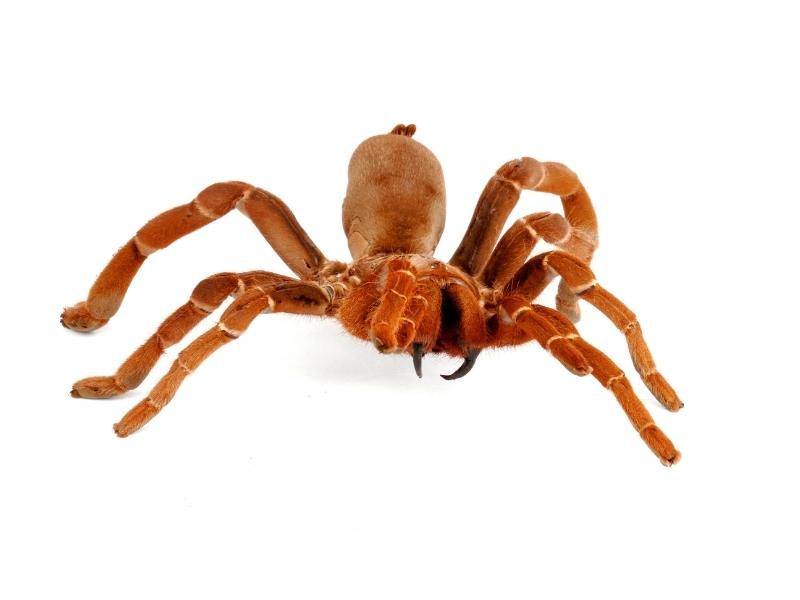
The king baboon spider is one of the largest tarantula species in the world. The spider has a bulky, copper-hued, velvety body with fine hairs and black, shiny fangs. Like most baboon species, the tarantula has thickened, curved back legs for burrowing. Males are smaller, hairier, and slimmer than females.
The king baboon tarantula uses its pedipalps — a pair of feelers on top of the head — to find and catch prey.
Size and Lifespan
The average life expectancy of the king baboon spider is between 10 and 15 years for males and up to 25 years for females. Poor sanitary conditions, improper parameters, and a lack of nutrients can drastically shorten a tarantula’s life expectancy.
King baboon tarantulas grow to a large size, but very slowly. Females are larger than males and reach up to 8 inches long in terms of diagonal leg span (DLS), while males typically grow up to 6 inches.
A young king baboon spider’s growth rate depends on its genetics, diet, and temperature. Regular feedings and a warm enclosure will increase growth speed.
Molt sexing is the easiest way to identify a tarantula’s sex. A female’s molt will have a spermatheca, while a male’s molt will have a slit.
Temperament
King baboon tarantulas are highly defensive and will never back down from a fight. These spiders use various methods to protect themselves, including striking, rearing up, biting, and stridulation (when a spider rubs its front legs together to produce a loud hissing noise).
Because of their aggression and territorial nature, king baboon tarantulas shouldn’t be housed together. This species also shouldn’t be handled — although their bite isn’t lethal to humans, it can cause severe pain, irritation, and inflammation for several days.
King baboon tarantulas spend most of their time burrowing into the substrate. These spiders are active at night and rest during the day.
Housing King Baboon Tarantulas
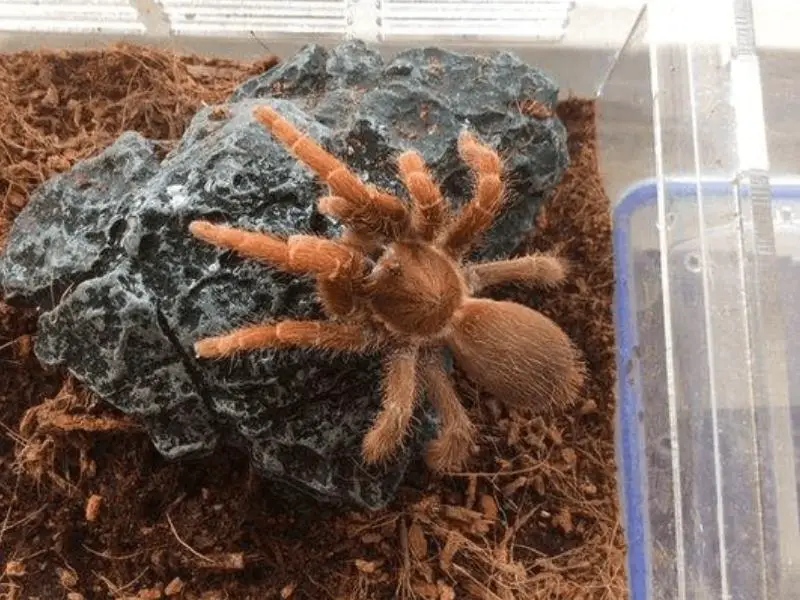
In the wild, the king baboon tarantula primarily lives in hot, humid environments with a deep substrate for burrowing. Replicating this natural habitat in the enclosure helps the spider live a long, healthy life.
House king baboon tarantulas in a wide, 15-gallon terrarium with a secure lid that still allows ventilation.
Enclosure size
A mature king baboon tarantula should be housed in an enclosure of 15 gallons or larger. Ideally, the terrarium should be three times the size of the tarantula’s total leg span.
The enclosure must be able to accommodate a deep substrate because king baboon tarantulas love to burrow and dig.
Lighting
UVB lighting isn’t needed. The king baboon tarantula is a nocturnal species that is most active at night.
Avoid placing the spider’s terrarium in direct sunlight, and provide low lighting for 9 to 12 hours daily to simulate a natural day to night cycle.
Temperature and Humidity
King baboon tarantulas thrive in temperatures between 72 and 78°F. In cooler climates, heating pads can be used to warm the enclosure up to the appropriate temperature levels.
Creating a thermal gradient in the terrarium — having a cool end and hot end — can also improve the tarantula’s overall comfort and allow it to properly regulate its body temperature. Don’t use heat lamps because they can cause the tarantula to dry out and become dehydrated.
The enclosure should stay at a humidity range between 70 and 80%. Spray the substrate regularly and place a large, sturdy water bowl in the enclosure to maintain the correct humidity.
Monitor the enclosure’s parameters twice daily, using a dual thermometer and hygrometer, to ensure fluctuations are kept to a minimum. Improper levels can cause discomfort, dehydration, and infections.
Substrate and Decoration
King baboon tarantulas need a thick layer of substrate for burrowing and digging. Humus, compacted sand, peat moss, and potting soil are suitable options as these substrates are readily available, cheap, and pliable. Avoid materials that are abrasive or don’t hold their shape.
The substrate should be at least 8 inches thick for an adult king baboon tarantula, or up to 3 inches thick for a young spider.
Decorate the terrarium with rocks, caves, logs, and artificial plants to provide the tarantula places to hide. However, ensure the decorations are sturdy and placed at the bottom of the enclosure rather than above the substrate. Otherwise, these decorations could fall and injure the king baboon tarantula while it burrows.
Add a large, shallow water dish to give the king baboon spider a clean water source and a place to cool down.
Cleaning
Cleaning the king baboon tarantula’s terrarium helps keep the environment sanitary, lessens foul-smelling odors, and prevents mold and fungus outbreaks.
Spot clean the enclosure once per day to remove leftover food, waste, and moldy substrate, though be extremely cautious and don’t disturb or startle the king baboon tarantula. Ideally, clean during the day when the tarantula is out of sight and resting in its burrow. Use long tongs or forceps and never reach into the enclosure with your hands.
Deep cleaning isn’t necessary unless the tank is emitting extremely foul odors or has a mold or fungus outbreak. Most tarantulas only require a deep clean once a year. Remove the spider and scrub everything down, including the enclosure walls, with warm water. Use a soft-bristled brush to tackle grime or tough stains.
Don’t use harsh chemical products like bleach as these emit toxins that can be lethal for tarantulas. Leave the decorations to dry before adding them back into the enclosure. Discard the substrate and replace with a new batch.
Here’s how to safely move the king baboon tarantula to a different enclosure while cleaning:
- Wait until the tarantula comes out of its burrow or hiding spot
- Lure the king baboon tarantula into an open plastic container
- Once the tarantula enters the container, slowly cover the opening with a thin sheet
- Gently place the container into the separate enclosure, with the opening facing down
- Slowly slip out the thin sheet and lift up the container
The separate enclosure should have a thick substrate and the same humidity and temperature levels as the main enclosure.
Replace the water daily and disinfect the actual bowl once a week.
King Baboon Tarantula Care
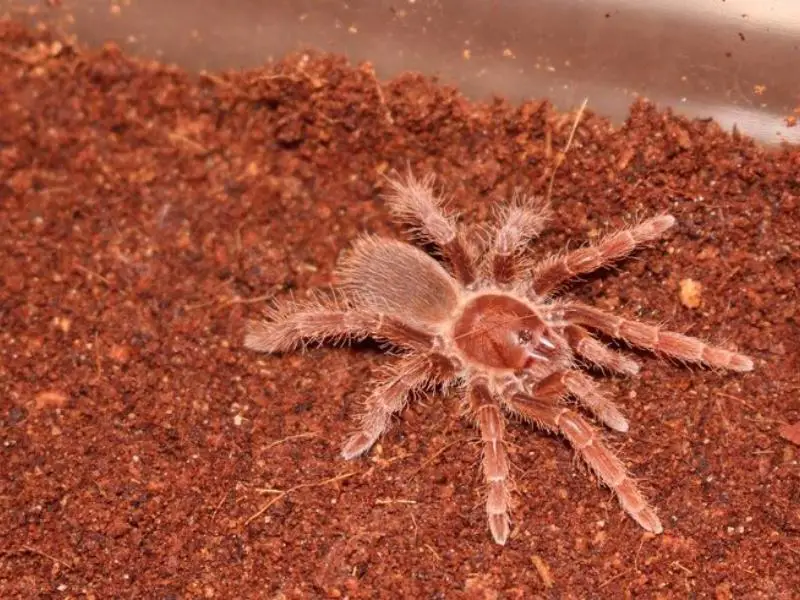
Caring for a king baboon tarantula is difficult because this species is highly aggressive and at risk of injury due to its burrowing behavior and fragile body.
A protein-rich diet, pliable substrate, and regular cleaning help king baboon spiders thrive.
Food and Water
King baboon tarantulas aren’t fussy eaters. These spiders are opportunistic carnivores and will eat any prey that comes their way in the wild, including small rodents, earthworms, crickets, and cockroaches.
Give king baboon tarantulas a protein-rich varied diet consisting of grasshoppers, crickets, roaches, and Tenebrio larvae. Gut loading prey helps ensure these spiders get all the necessary nutrients.
Feed the king baboon tarantula once a week or less often during molting periods. Supplement this diet with the occasional pinkie mouse, though always ensure portions aren’t larger than the tarantula’s abdomen.
Slings require more food to support their growth, ideally around two to three feedings per week. Suitable foods for slings include pre-killed pinhead crickets, mealworms, or large cricket legs.
Drop the king baboon tarantula’s food into the enclosure at night to match its hunting habits. Remove leftover food within a few hours to prevent the terrarium from becoming dirty, and top up the water bowl with clean water daily.
Handling
King baboon tarantulas shouldn’t be handled. This species is defensive and delivers a nasty bite. A fall from a height can also injure the tarantula’s delicate body.
Common Health Issues
King baboon spiders are hardy and can live for up to 25 years with proper care. However, like all tarantulas, they’re susceptible to ailments such as dehydration, mites, and injury.
- Dehydration: Occurs when the enclosure is dry and has an excessive amount of ventilation. Symptoms of dehydration include lethargy, a shriveled appearance, shrunken abdomen, and appetite loss. Mist the substrate, reduce ventilation, and top up the tarantula’s water daily to treat dehydration. Use a hygrometer to check the humidity level
- Mites: Mites are extremely common in tarantula enclosures, and while a small amount of mites won’t pose an issue, an outbreak can distress the spider. Ensure the terrarium has cross-ventilation and clear leftover food immediately to keep the mite population low
- Injury: King baboon tarantulas have delicate bodies. Falls from a height, or decorations collapsing on top of these spiders as they burrow, can cause life-threatening injuries and even death. Most injuries are preventable with proper placement of decorations and ensuring the substrate is soft yet firmly packed. Hobbyists should also avoid handling this species
Molting
King baboon spiders grow slowly and don’t molt as much as other tarantula species. Adults molt around once a year on average, though expect spiderlings to molt more frequently because they’re still growing.
Signs a spider is about to undergo molting include appetite loss, lethargy, and increased web spinning activity. During the actual molting, the king baboon tarantula will lie on its back and shouldn’t be disturbed. Remove the excess exoskeleton once molting is complete.
King baboon tarantulas, like all species, need a high humid environment to shed safely. Mist the substrate and enclosure walls daily to increase the humidity level.
After molting, most king baboon tarantulas are ready to eat meals again within a week, though large adults can take up to a few weeks to fully recover.
Breeding
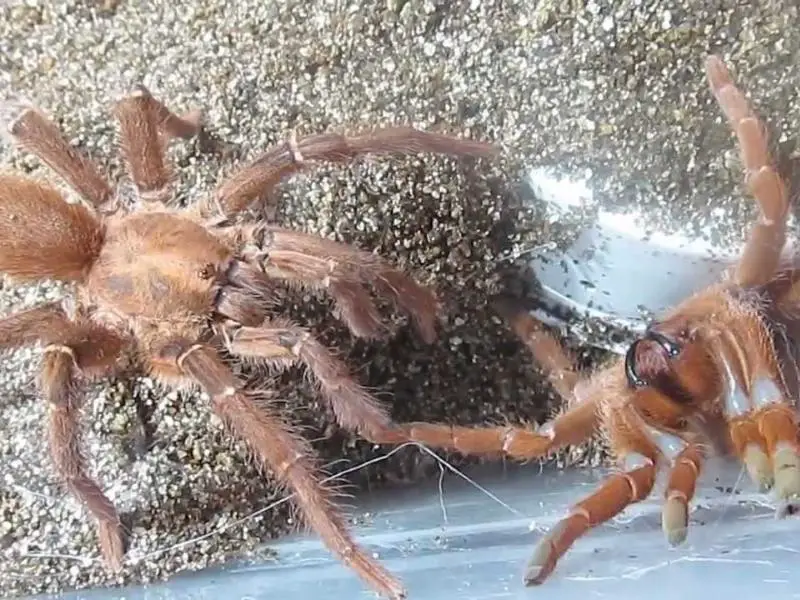
Breeding king baboon tarantulas at home are challenging because of their territorial and aggressive nature. Mating also typically occurs within the tarantula’s burrow, meaning rescuing males is virtually impossible.
Most captive-raised king baboon tarantulas in the trade originate from wild-caught egg sacs. Only experienced hobbyists should consider breeding this species, and really only under the guidance of a reputable breeder. Here are the general steps to follow once a well-conditioned pair is acquired:
- Ensure both the male and female are well-fed before the breeding process begins
- Once the male has created a sperm web, introduce him into the female’s enclosure. Place the male as far away as possible from the female king baboon tarantula
- Examine the pair closely. If the female tries to attack the male, quickly separate the pair with a piece of sheet or other tool. Use a plastic container to remove the male
- If the female is reciprocative, the pair will mate and lock together
- After the pair has finished, remove the male immediately to prevent the female from attacking him
- Feed the female a protein-rich diet around two to three times per week. The female will become plump and produce a silk egg sac within two months. The eggs will hatch after four to eight weeks
- Don’t remove or disturb the female’s offspring until they’ve separated and spread throughout the enclosure. King baboon tarantulas are protective over their young and will attack anything that approaches
- The spiderlings are hardy, grow slowly, and should be kept in humid containers with a thick substrate. Don’t keep the spiderlings together because this species engages in cannibalism
Choosing and Buying a King Baboon Tarantula
Expect to pay between $50 and $200 for a king baboon tarantula, with the exact cost depending on sex, age, size, and breeder. Large female spiders can cost significantly more than $200, while young spiderlings under 2 inches are the cheapest, with most sold at $10 and $30.
King baboon tarantulas aren’t commonly found in pet stores, though are sometimes stocked in online specialist stores. Buying from a reputable breeder gives you the best chance of obtaining a healthy, well-raised spider.
Avoid tarantulas that appear sick or distressed. Signs of illness include lethargy, a shriveled appearance, abnormal movements, a lack of appetite, bald patches, and parasites.

